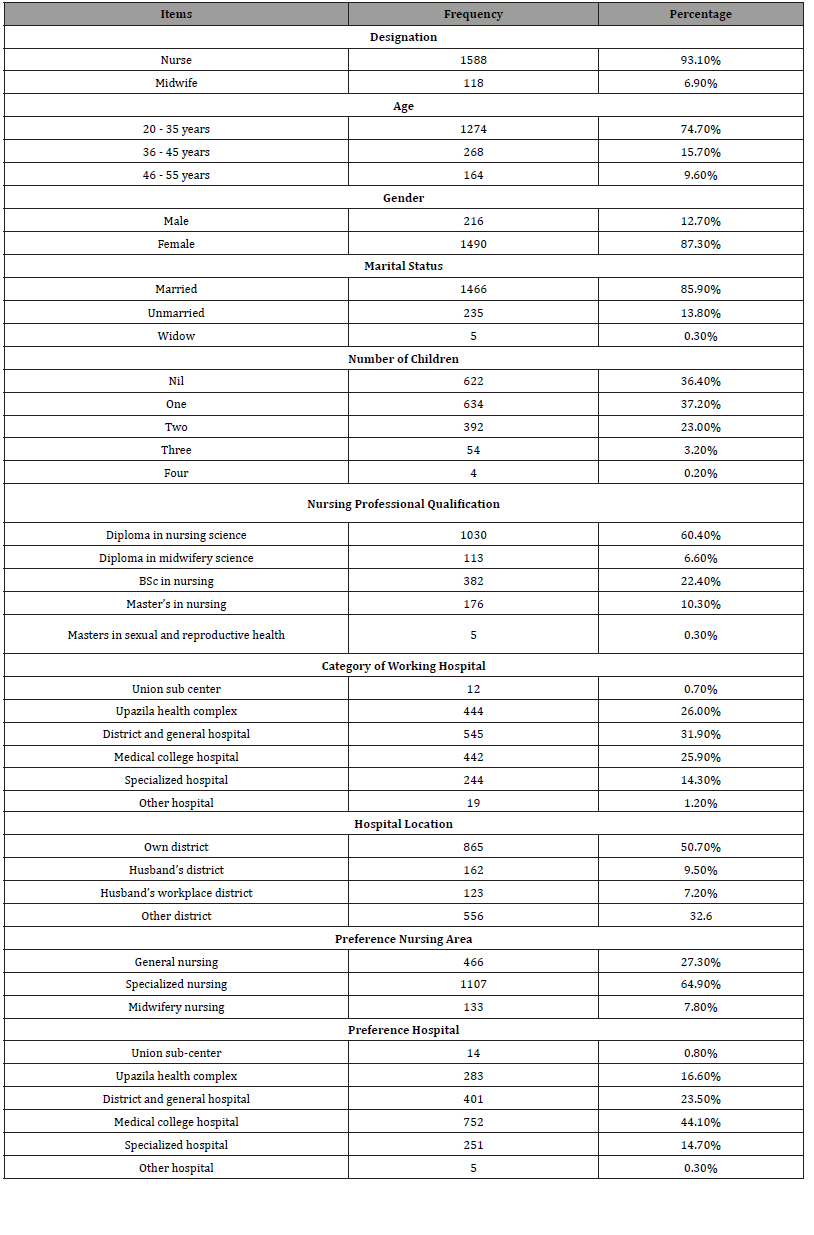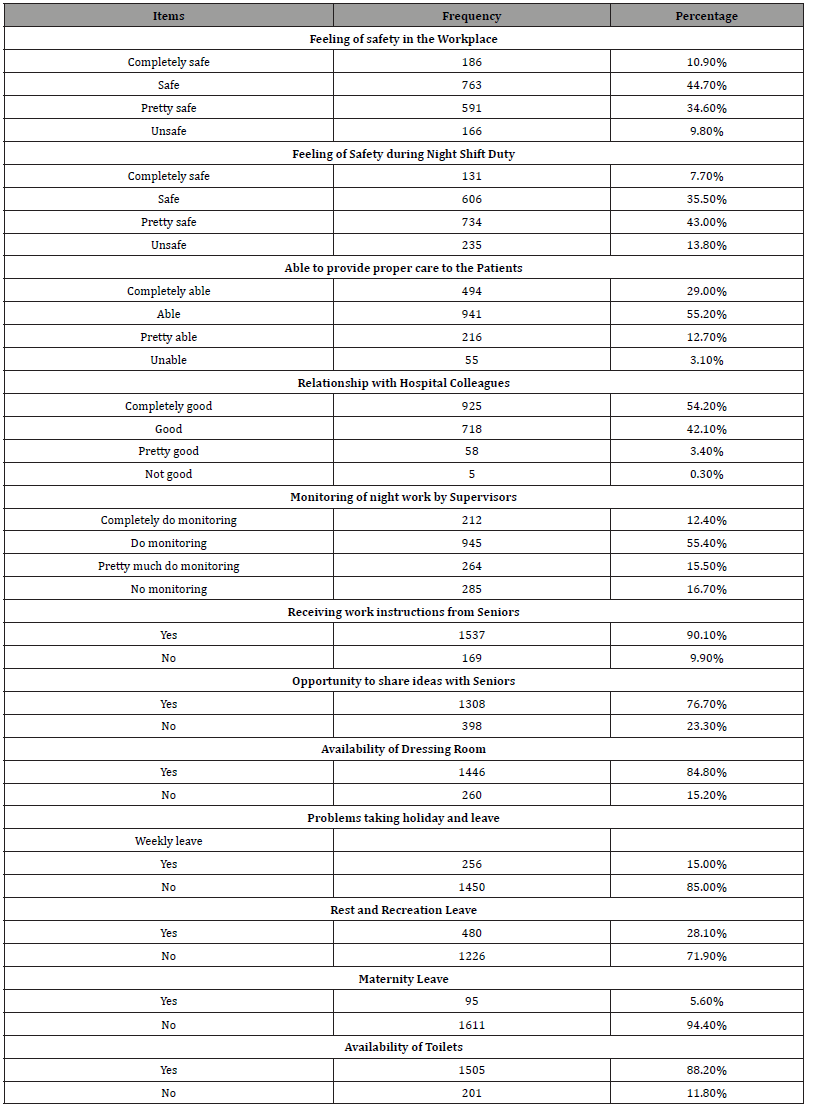 Research Article
Research Article
Nurse and Midwife Workplace Barriers in Bangladesh
Mohammad Abbas Uddin*, Rabeya Basri and Mala Reberio
Nursing and Midwifery Research, Directorate General of Nursing and Midwifery, Bangladesh
Mohammad Abbas Uddin, Nursing and Midwifery Research, Directorate General of Nursing and Midwifery, Bangladesh.
Received Date:Sep 02, 2022; Published Date:Sep 23, 2022
Abstract
Nurses and midwives face workplace barriers that impact their work activities. To ensure quality nursing and midwifery care, it’s important to identify and resolve these barriers. Studies have identified and categorized the barriers affecting these healthcare workers. The aim of this survey study was to identify the specific barriers encountered by nurses and midwives in Bangladesh. This was a descriptive quantitative survey study. A self-reported questionnaire containing 10 items developed by the researchers was used to collect the nurses’ and midwives’ workplace barrier data. The participants were 1706 nurses and midwives. Descriptive statistics were used to analyze the nurses’ and midwives’ demographic and workplace barriers data. The study found that workplace barriers experienced by nurses and midwives included feeling unsafe, being unable to provide proper patient care, a lack of relationships with hospital colleagues, a lack of monitoring and work instructions, little opportunity to share ideas, and a lack of dressing rooms and toilets. Participants also faced difficulties getting weekly leave, rest and recreational leave, and maternity leave. Nurse and midwives experienced various workplace barriers. Resolving these barriers will contribute to a safe workplace, improve nurses’ and midwives’ performance, and improve the quality of nursing and midwifery care.
Keywords:Nurses; Midwives; Workplace barriers
Introduction
Nurses and midwives are well-known figures in hospitals. They are responsible for providing and coordinating nursing and midwifery care, preventing adverse health effects, and optimizing the use of health care facilities for patients [1]. Nurses and midwives require a safe, satisfying, and empowering workplace [2]. These qualities are essential to providing high-quality nursing and midwifery care and ensuring high-quality nurse and midwife job performance [3]. The Bangladesh government has made various efforts to increase and improve nursing and midwifery provision. Their goal has been to ensure the quality of nursing and midwifery care and achieve Sustainable Development Goals (SDGs). In response to hospitals’ demands, the government has deployed a remarkable number of nurses and midwives across the country.
The Directorate General of Nursing and Midwifery (DGNM) is the regulatory body for the 42,239 nurses and 2,546 midwives working in government organizations in Bangladesh. These figures include nurse and midwife administrators, managers, teachers, and clinical nurses and midwives. DGNM supports the provision of safe hospital workplaces for nurses and midwives.
It is necessary to identify the workplace barriers that nurses and midwives experience and find solutions for resolving these barriers. This may contribute to improving nursing and midwifery care and also its outcomes. Studies among midwives have found that they experience social, professional, and economic barriers [4,5] and that they have expressed concerns about hospital equipment, housing, and transportation [6]. However, there are few studies of the specific workplace barriers experienced by nurses and midwives working in Bangladesh. Therefore, the aim of this study was to identify the workplace barriers specific to Bangladesh. The results of this study will help nurse and midwife managers, administrators, and hospital authorities to improve nurses’ and midwives’ workplaces.
Data and Methods
This was a descriptive quantitative survey study. The participants were 1706 Bangladeshi nurses and midwives working at government hospitals as direct care providers. Data were collected through online self-reported questionnaires. A formal request for participants to take part in this study and the study questionnaire were placed on the DGNM website. The duration of the study survey was 10 days.
The survey study questionnaire consisted of two parts:
1. A demographic questionnaire and
2. A workplace characteristics questionnaire (developed by
the researcher)
The questionnaires were validated by three expert nurses.
The demographic section included 10 items:
• Designation
• Age
• Gender
• Marital status
• Number of children
• Professional educational qualification
• Working hospital category, hospital location
• Preferred nursing area, and preferred hospital
The workplace section also included 10 items:
• Feeling safe in the workplace
• Feeling safe during night shift duty
• Being able to provide proper care to patients
• Relationships with hospital colleagues
• Monitoring of nurses’ and midwives’ night work by
supervisors
• Availability of dressing rooms
• Availability of toilets
• Receiving work instructions from senior staff in charge of
wards
• Opportunities to share ideas
• Opportunities to take leave
Items 1-5 were recorded via a 5-point Likert scale (4 to 0). Items 6-10 were recorded via a 2-point Likert scale (1 to 0). After completion, 10 days’ data were downloaded and organized. The incomplete data were excluded. Finally, 1706 participants’ data were analyzed using the SPSS program. Descriptive statistics, including frequency and percentage, were used to describe the participants’ demographic and workplace responses.
Results
Demographic information
The majority (93.1%) of the participants were nurses. The remainder (6.9%) were midwives. Most were between 20 and 35 years old (74.7%), female (83.3%), and married (85.9%). 37.2% of participants had one child. 60.37% held a diploma in nursing science and 31.9% were working in district or general hospitals. More than half (50.7%) were working in their own district. 64.9% preferred to be a specialized nurse and 44.1% preferred to work in a medical college hospital (Table 1).

Nurses and midwives workplace barriers
9.8% of participants reported feeling unsafe at work and 13.8% felt unsafe during night shifts. More than fifty participants (3.1%) felt unable to provide proper patient care. Only 5% reported no good relationships with hospital colleagues. However, 16.7% said that their night shift duty was not monitored by their supervisors, 9.1% did not receive work instructions from senior ward staff, and 23.3% had no opportunity to share ideas with seniors. 15.2% did not have access to a dressing room and 11.8% could not access a toilet. Moreover, participants reported problems taking (15.5%) weekly leave, (28.1%) rest and recreation leave, and (5.6%) maternity leave (Table 2).

Discussion
The present study found that about 10% of participants felt unsafe at work and about 14% of participants felt unsafe during night shifts. Participants’ age, gender, and hospital category may be a factor in this. Most participants were female (83.3%) and most were aged between 20 and 35 (74.4%). Workers in these demographic groups might fear sexual harassment or violence. In addition, participants worked at different categories of hospital (including union sub-center, upazila health complex, district/general hospital, medical college hospital and specialized hospital). These hospitals, and their structures and systems, may not be supportive enough of employee safety (or perceived safety). The finding that feeling unsafe at work is a barrier to effective nursing and midwifery is consistent with other studies, which identified social barriers [7] and personal or organization-based perceived disrespect barriers [4-6].
Some participants (3.1%) felt unable to provide proper patient care. This might be a result of hospital systems, particularly nurses’ and midwives’ workloads, unavailability of hospital supplies, and lack of a supportive environment. This is consistent with a previous study which identified professional and economic barriers [6]. A few participants (.3%) were unable to build relationships with hospital colleagues. This might be due to specific personal issues and is similar to the findings of a study which identified personal self-barriers [5]. 16.7% of participants reported that their night shift duty was not monitored by their supervisor. This may be a result of a lack of supervisors, or their workloads may not allow time for this task. This barrier is similar to that found in a study which identified professional barriers [7] and organization-based perceived disrespect barriers [5].
In addition, 9.1% of participants reported not receiving work instructions from senior ward staff and 23.3% of participants did not have the opportunity to share their ideas with seniors. This may be caused by the senior staff in charge of the ward and may reflect managers’ unwillingness or inability to inform and include their staff. This barrier is similar to the personal and organizationbased perceived disrespect barriers identified in another study [7]. 15.2% of participants reported the unavailability of dressing rooms and 11.8% reported the unavailability of toilets. This absence of basic facilities may be a result of hospital structures. The finding is similar to that of a study that found organization-based perceived disrespect barriers [7]. Finally, participants faced problems taking weekly leave (15.5%), rest and recreation leave (28.1%), and maternity leave (5.6%). These problems may have been caused by hospital systems and a shortage of nurses and midwives. This finding is consistent with a study that identified economic barriers [5].
Conclusion
Nurses and midwives experienced workplace barriers, including feeling unsafe, being unable to provide proper patient care, lack of relationships with hospital colleagues, absence of monitoring, lack of work instructions, little opportunity to share ideas, and unavailability of dressing rooms and toilets. In addition, participants confronted difficulties in taking weekly leave, rest and recreation leave, and maternity leave. To improve nursing and midwifery care and nurses’ and midwives’ job performance, it is important to find solutions to these workplace barriers.
Recommendations
Study may be conducted in different hospital settings, including Union sub-center, Upazila health complex, District and general hospital, medical college hospital, and Specialized hospital. The study findings might be useful for the nurse and midwife administrator and managers and also for hospital authority to minimize the nurses and midwives experienced workplace barriers.
Ethical Considerations
Permission to collect data was obtained from the nurses and midwives regulatory body.
Acknowledgement
The authors were pleased to the nurses and midwives for their participation. The authors also pleased to the nurses and midwives regulatory body for data collection permission and support to conduct the survey study.
Conflict of Interest
No conflict of interest has been stated by the researchers.
References
- Aiken LH, Sloane DM, Bruyneel L, Van den Heede K, Griffiths P, et al. (2014) Nurse staffing and education and hospital mortality in nine European countries: A retrospective observational study. Lancet 383(9931): 1824-1830.
- American Nurses Association (2018) Healthy work environment.
- Wei H, Sewell KA, Woody G, Rose MA (2018) The state of the science of nurse work environments in the United States: A systematic review. Int J Nurs Sci 5(3): 287-300.
- Bogren M, Erlandsson K, Members of the Midwifery Faculty Master’s degree holders in Sexual and Reproductive Health and Rights, Ulrika Byrskog (2018) What prevents midwifery quality care in Bangladesh? A focus group enquiry with midwifery students. BMC Health Serv Res 18(1): 639.
- Byrskog U, Akther HA, Khatoon Z, Bogren M, Erlandsson K (2019) Social, economic and professional barriers influencing midwives’ realities in Bangladesh: a qualitative study of midwifery educators preparing midwifery students for clinical reality. Evidence Based Midwifery 17(1): 19-26.
- Rashid U Zaman, Adiba Khaled, Muhammod Abdus Sabur, Shahidul Islam, Shehlina Ahmed, et al. (2020) Experiences of a new cadre of midwives in Bangladesh: findings from a mixed method study. Hum Resour Health 18(73).
- Nouri A, Sanagoo A, Jouybari L, Taleghani F (2021) Contextual barriers of a respectful workplace in nursing: A focused ethnography. Iran J Nurs Midwifery Res 26(4): 349-354.
-
Mohammad Abbas Uddin*, Rabeya Basri and Mala Reberio. Nurse and Midwife Workplace Barriers in Bangladesh. Iris J of Nur & Car. 4(1): 2022. IJNC.MS.ID.000577.
-
Nurses, Midwives, Workplace barriers, Administrators, Managers, Teachers, Clinical nurses, Descriptive statistics, Including frequency, Percentage, Designation, Age, Gender, Marital status, Number of children, Professional educational qualification
-

This work is licensed under a Creative Commons Attribution-NonCommercial 4.0 International License.






